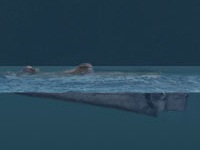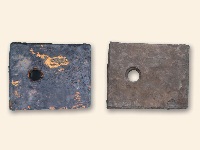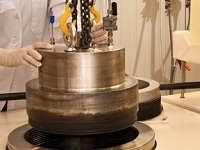learning from the Hunley
stories by Frank Stephenson
A submarine that made history delivers another potent payload, this time for science.
1864. Strangled by a necklace of Union warships wrapped around its seaports, the three-year-old Confederacy was on its deathbed, and its puny navy could do little about it. From the crucible of desperation, the South forged an improbable secret weapon: a hand-cranked attack boat. Built and tested in Mobile, Alabama, in 1863, and delivered to Charleston by rail on August 12, 1863, the H.L. Hunley was designed to do what no vessel in the world had ever done: sink a warship from beneath the waves.
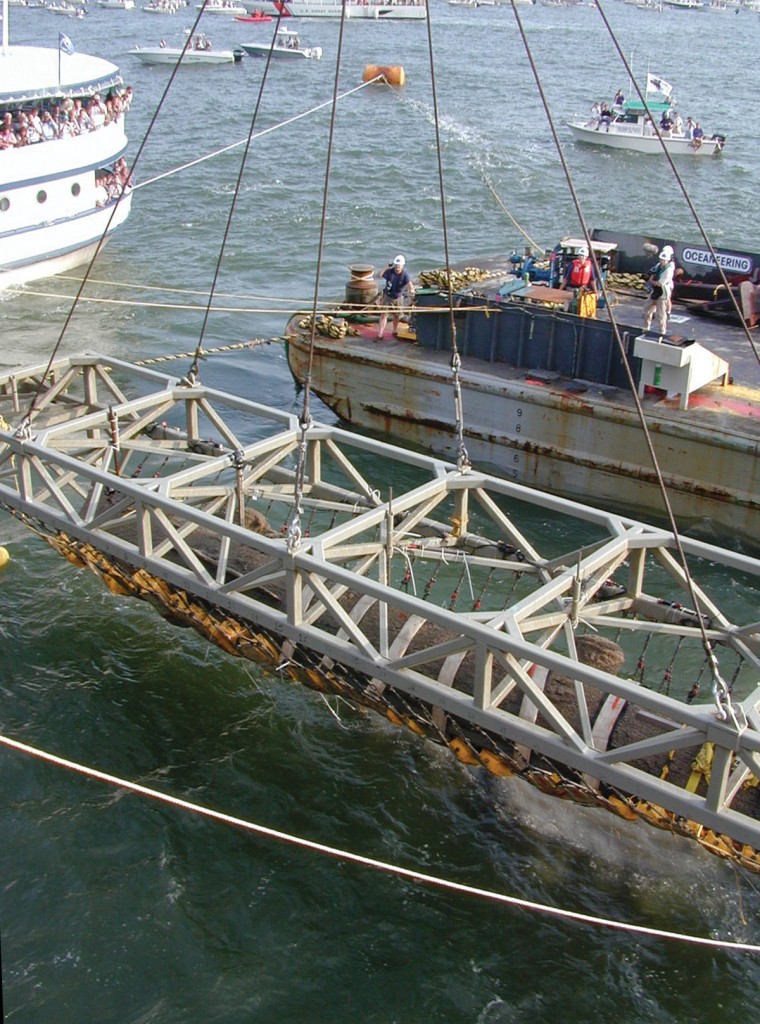
Hundreds of onlookers cheered as the Hunley broke the surface of Charleston Harbor on the morning of August 8, 2000, for the first time in 136 years. Image courtesy Friends of the Hunley.
On the chilly, moonlit evening of February 17, 1864, the H.L. Hunley pushed out of Breach Inlet, just north of Charleston Harbor, headed for destiny. In its cramped, clammy hull, seven men led by twenty-four-year-old Lt. George E. Dixon, attached to the 21st Alabama Infantry, sat hunched over at their stations, stoically cranking their craft to sea. Almost two years before, Dixon had been spared a mortal wound in the battle of Shiloh, thanks to a twenty-dollar gold piece that he carried in the left pocket of his trousers. The heavy coin deflected a Yankee musket ball that otherwise could have shattered his left femur, a wound that most likely would have been fatal. Dixon had carried the bent coin with him as a good luck piece ever since, and this night was no exception.
Read more about Dixon’s twenty-dollar gold piece.
Around 8:45 p.m., the Hunley homed in on her target, the 207-foot, 1,200-ton federal sloop-of-war U.S.S. Housatonic, which was placidly riding anchor about four and a quarter miles due east of Breach Inlet.
Although it had been designed to attack while completely submerged, the Hunley brazenly charged its target on the surface at a speed of no more than four knots. A suddenly alarmed watch crew aboard the Housatonic began firing their pistols and big-bore rifles point blank at the approaching menace, but too late. The Hunley’s seventeen-foot-long iron spar, carrying a heavy keg of black powder, found its mark on the Housatonic’s starboard quarter. Seconds later, a huge explosion disintegrated much of the great ship’s aft quarters. In minutes, the ship sank stern first in twenty-seven feet of water, and then heeled over to port, its surviving captain and crew clinging to its mast and rigging. Five Union seamen lay dead in the wreckage. It was the first successful submarine attack in naval history, and it became one of the most intriguing and enduring tales of the American Civil War.
But soon after the attack, the Hunley promptly vanished into a cold sea without a trace.
Reunion
April 17, 2004. In Charleston’s Magnolia Cemetery, thousands gathered for a funeral, along with reporters from more than four hundred media outlets from around the world. After one hundred and forty years, all twenty-one men and boys who died serving aboard the H.L. Hunley were reunited at last. Fittingly, the country’s last commemoration of Confederate dead had come to Charleston, the very place where the Civil War began.
The ceremony capped a long and all-but-abandoned search that had ended in 1995, during an expedition led and funded by famed novelist-cum-marine explorer Clive Cussler. That summer, Wes Hall and Harry Pecorelli, two marine archaeologists groping through the mucky floor of Charleston Harbor, became the first humans to touch the Hunley in one hundred and thirty-six years. Five years later, on August 8, 2000, the ten-ton vessel—filled with around thirteen tons of silt burying its final crew—was gingerly plucked from its muddy grave and transported to where it lies today, in a North Charleston water tank the size of a swimming pool. Now into its twelfth year, the project—the likes of which archaeologists had never seen—is run by an international team of specialists. Since January 2007, the team has been under the exclusive management of the Clemson University Research Institute (CURI).
Pushing the boundaries
Before stepping down in August, Michael J. Drews directed CURI’s Warren Lasch Conservation Center, the Hunley’s home at a decommissioned navy base on the west bank of Charleston’s Cooper River since the sub’s recovery. He managed the project and its international team of specialists beginning in January 2007. Formerly on the faculty of Clemson’s School of Materials Science and Engineering, Drews directed the center’s day-to-day operation. His job was to make sure that the center’s work stayed focused on its number-one mission, namely to study and conserve the Hunley to the fullest extent possible so that the old vessel’s significance to history and culture and to education and science is passed on to posterity.
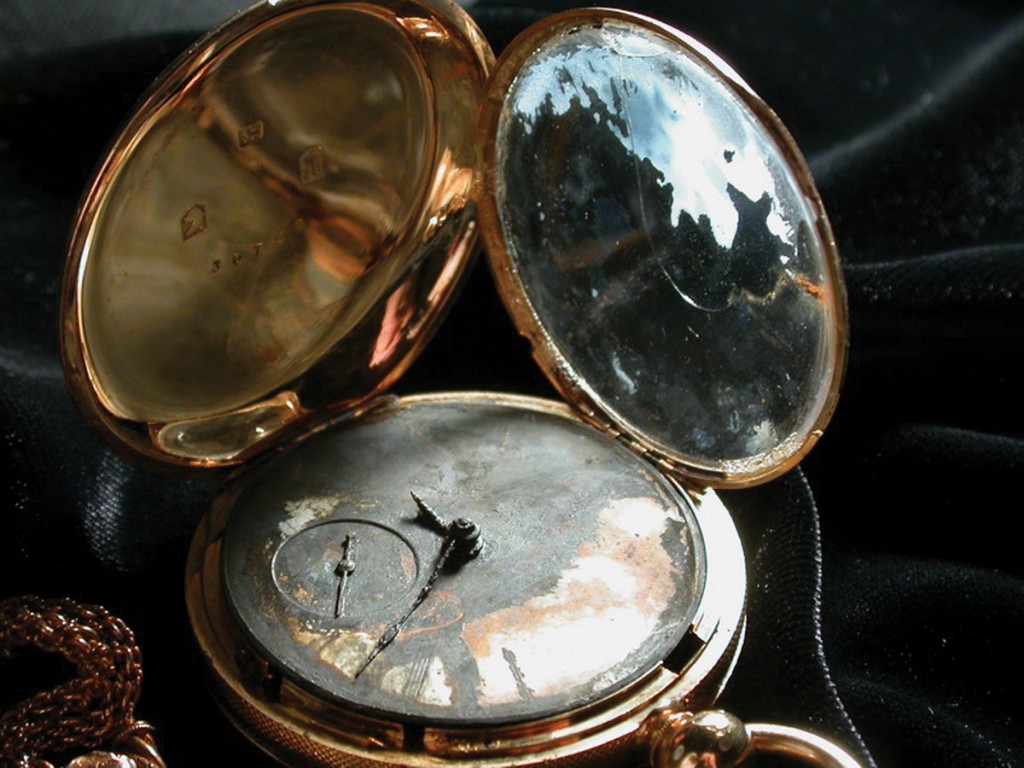
Lt. Dixon’s gold watch stopped at 8:23. A team of conservators including Paul Mardikian painstakingly cleaned and preserved its intricate parts. Image courtesy Friends of the Hunley.
“Our goal is not just to do conservation and archaeology but to push the boundaries of science in both areas,” Drews says. He first connected with the Hunley in 2001, when Paul Mardikian, senior conservator at the Lasch Center, made a presentation at Clemson about the conservation project. Among many other artifacts recovered from inside the vessel, Mardikian had found pieces of fabric—shreds of clothing worn by the Hunley’s crew. These remnants, along with the remains of the crew that wore them, were extremely degraded and required expert analysis. Drews happened to be in Mardikian’s audience that day.
“This turned out to be a great example of the fields of materials science and conservation coming together,” Drews recalls. “Paul was interested in conserving, identifying, and characterizing the fabric he’d found. We talked and I thought I might be able to help.”
Discussions led to Drews coming to the Lasch Center in 2003 on a sabbatical (his first since joining Clemson’s faculty in 1972). An expert in using high-pressure fluids to treat and modify fabrics—technology used by industry to dye cloth—Drews began a series of experiments in treating a variety of samples and rivets recovered from the Hunley. The work resulted in a patent, filed in 2006, that describes a revolutionary treatment of iron objects recovered from saltwater environments.
It’s a submarine!
On a clear May morning, Mike Drews walks us down the hall of the Lasch Center to a set of bay windows that overlook the floor below. Sunlight pouring through two large skylights brightly illuminates a tank of clear water and the long, dark mass inside.
It’s the Hunley, all forty-two feet of her, sitting upright with her bow pointed to the northwest, the course that would have carried her and her crew safely home long ago had fate been more kind. Beneath the shimmering surface of the green pool, her crusty brown skin seems to crawl. Ominously, she looks like a stealthy leviathan, asleep perhaps, but no less the lethal creature of the sea she was built to be.
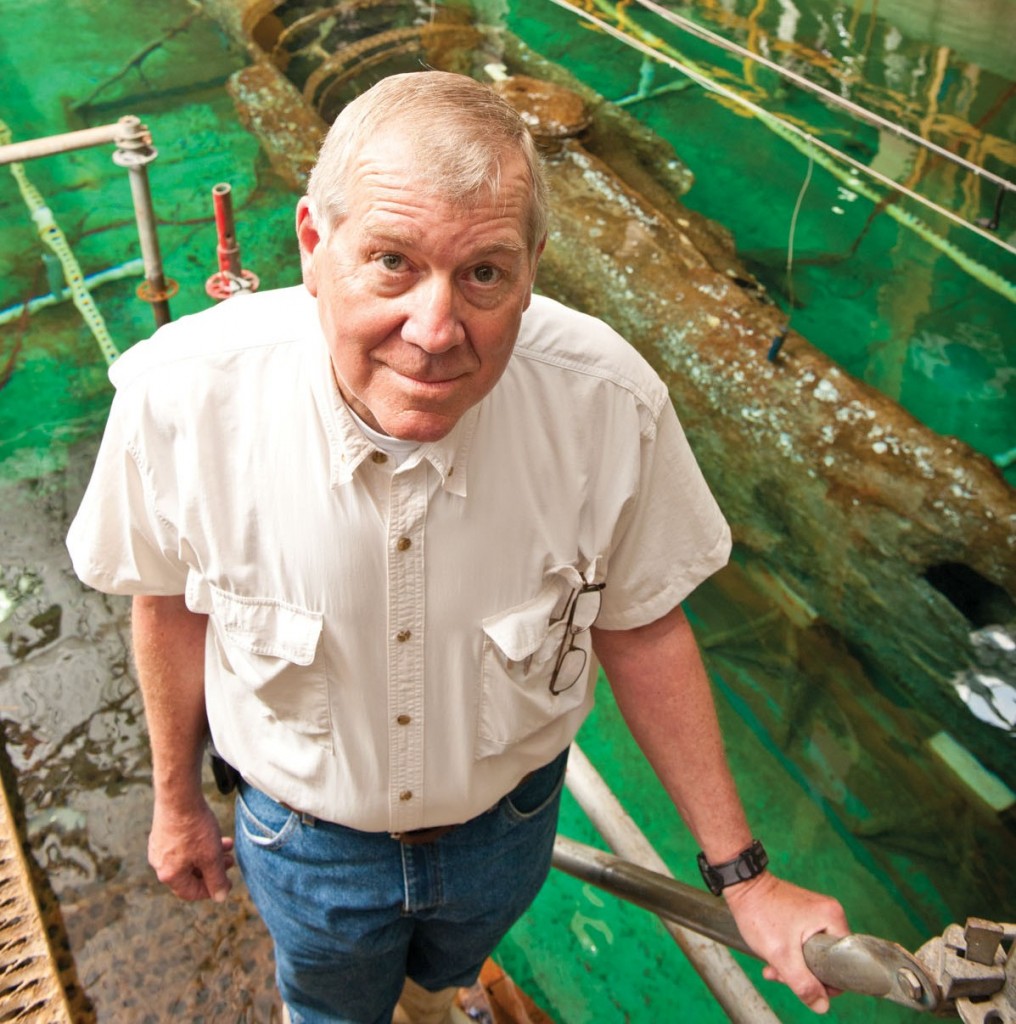
Michael Drews at a tank equipped to keep the Hunley intact during archeology and conservation. Image courtesy Ray Stanyard.
Looking down on her fish-sleek frame, one thing stands gin clear: The thing is a submarine!
From a closer range below, a tour group leans against a safety rail, gawking, as a volunteer with the Friends of the Hunley, the nonprofit group that spearheaded the first years of the Hunley project, explains what they’re seeing. Every year, some 40,000 visitors to Charleston put the Lasch Center on their must-see list.
Drews says our visit is well timed.
We’re among the first to see the Hunley in its entirety, sans the eight-ton truss assembly that had cradled the vessel from the day it was raised in 2000. The truss had enabled engineers to hoist the Hunley to the surface in the exact position she’d been found—lying 45 degrees on her starboard side. This costly, painstaking move was essential to prevent the vessel’s contents from being jostled, an archaeologist’s nightmare.
In July 2011, some seven years after the ship’s insides were excavated, engineers finally rotated the vessel to its original upright position. As a precaution, the truss stayed in place until January 12, 2012. With the truss pulled away, mortals suddenly had their clearest look at the H.L. Hunley since it sat, nearly 150 years ago, on a Confederate dock less than seven miles from its current home.
Unexpected marvel
No one has been at the frontlines of the Hunley project longer than Paul Mardikian and his colleague Maria Jacobsen. Both were hired by South Carolina’s newly formed Hunley Commission almost a year before the vessel broke the surface in the summer of 2000. The pair formed the vanguard of an all-pro team that would lead what everyone from the beginning knew lay ahead— many years of meticulous lab work.
The Danish archaeologist Jacobsen, previously with the Institute of Nautical Archaeology at Texas A&M University, is chief archaeologist at the Lasch Center, the namesake of local businessman Warren Lasch, who served as first chairman of Friends of the Hunley. As did her Sorbonne-trained colleague Mardikian, Jacobsen brought multiple years of globe-spanning experience to Charleston. She’s helped excavate old shipwrecks from Turkey to Texas.
Now a dozen years on, Jacobsen and Mardikian’s vantage point from the front row of the Hunley project has opened their eyes to a fragment of history with dimensions they never imagined. Neither researcher expected to find what they did in an artifact that Jacobsen has called “a technological marvel of its time.”
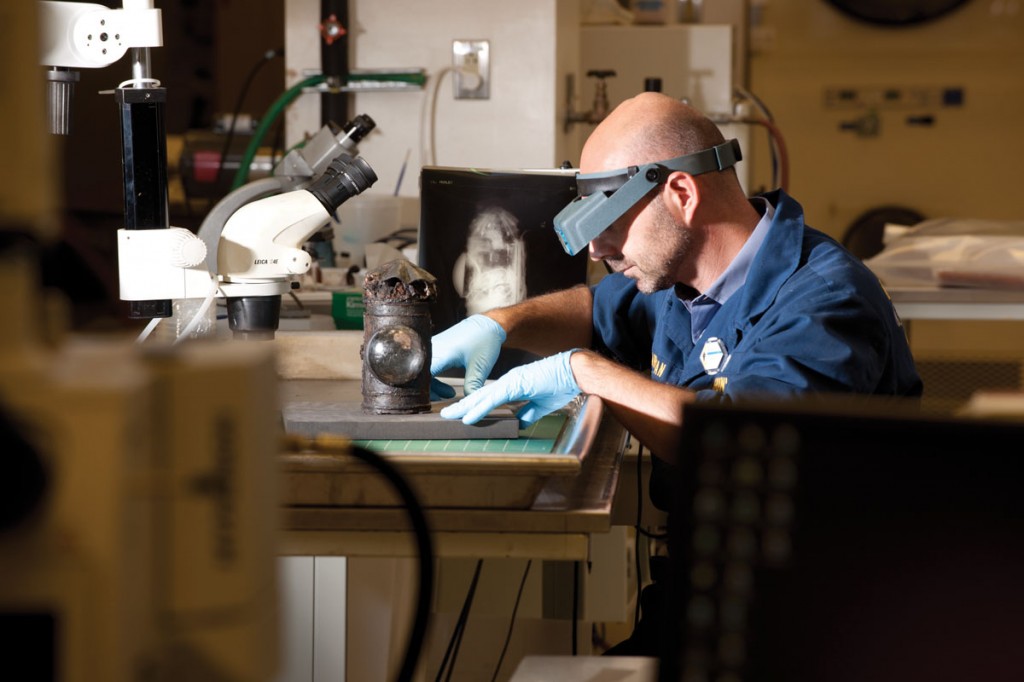
Tending the light: Chief conservator Paul Mardikian examines the Hunley’s lantern, a whale-oil light used mainly for signaling. The lantern was highly degraded, with some parts missing. Mardikian used X-rays showing the lantern’s “ghost” to reconstruct missing parts. Image courtesy of Ray Stanyard.
“Everything we thought we knew about this vessel turned out to be flat wrong,” Jacobsen says. All that she and her colleagues had read from the few surviving historical records on the Hunley —including descriptions written by men who not only served on her but who also helped design her—were found to be fraught with error.
From the full complement of crew thought to be required to operate the vessel—multiple records had indicated nine, yet only eight bodies were recovered—to the way the vessel was built and how its curious manpower propulsion system worked, one revelation atop another made for daily thrills for the Hunley team during the project’s early years. If you want to read more about the team’s discoveries, go to “Setting the record straight.”
Well before the boat’s mud-packed interior was explored, the vessel revealed its builders’ mastery of metalwork and craftsmanship. From its cast iron, knife-like bow to its elegantly contoured conning towers, the Hunley is a genuine tour de force of engineering for its time.
“When you consider the fact that this vessel was built out of desperation by people under incredible pressure, with few resources, you’d think they would have slapped something together quickly, just to get it out there,” Jacobsen says. “But that’s clearly not what they did. Everything about the Hunley bears the hallmark of something very finely crafted with a refined design.”
In an obvious effort to make the Hunley as sleek and efficient as possible, every single one of its thousands of rivets was hammered flush with its outer skin. In a pre-power tool era, this was a herculean job requiring men willing to work in hellish conditions, handling red-hot metal in painfully tight quarters.
The hull itself was found to be made up of a series of three-eighths-inch-thick wrought iron plates built specifically for the purpose, not salvaged from old boilers as legend had it. Typical boilers of the day were built with overlapping iron plates riveted together. On the Hunley, the plates’ edges are neatly butted up against each other and riveted to iron backing straps on the inside. These were juxtaposed by a series of iron stiffening rings, designed to help the hull withstand pressure at depth, a feature that most likely developed from trial and error (the Hunley had at least two precursors).
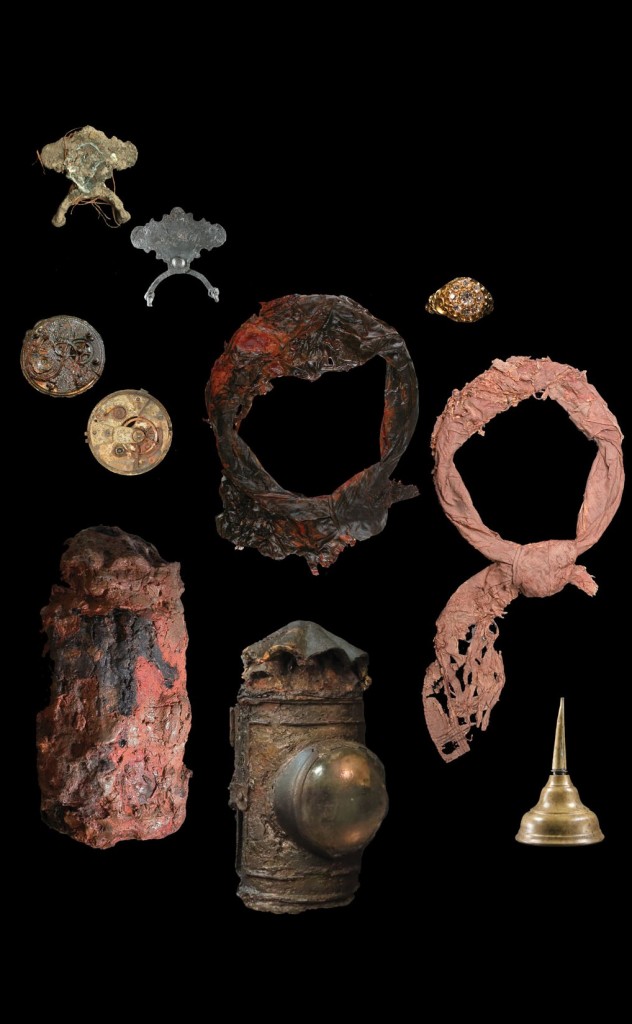
Science and the artifacts: The team carefully conserved the ship’s artifacts, using X-rays and ad¬vanced digital imaging to help guide the work. A few examples: (1) Lt. Dixon’s suspender buckle and (2) watch works before and after conservation. (3) Dixon’s diamond-studded ring. (4) A silk bandana before and after. (5) The Hunley’s lantern before and after. (6) A brass oilcan. Image courtesy of Friends of the Hunley.
Adding immeasurably to the Hunley’s speed and stealth was the care with which its designers shaped every detail of its exterior. The chiseled bow—forged to a thickness of a mere inch—allowed the vessel to cut through water with ease. The vessel’s smooth skin gives way to a drastically tapered keel ballasted with custom-made iron blocks, each seamlessly contoured to match the hull.
Once they had a chance to examine the Hunley’s insides, the team’s wonderment vaulted. They discovered levels of ingenuity that continually surprised them.
“When we tried to imagine, to predict, how the designers would have solved a problem, I don’t think anyone has been right once,” Mardikian says. “Every time, we’ve been blown away by their creativity and cleverness.”
Finished in July 1863, the Hunley (the vessel didn’t acquire the name until later) was the third true submarine that a team largely made up of well-to-do New Orleans-based engineers and businessmen had built since the war began. The first, Pioneer, was built in New Orleans and scuttled when the town fell to Union forces. The second, American Diver, built in Mobile, sank during sea trials somewhere off Fort Morgan. Neither vessel survived long enough to see combat.
Given the Hunley’s appalling track record—before its final (and fatal) mission, it sank twice during practice runs in Charleston Harbor, killing thirteen crewmen including its namesake, Horace Lawson Hunley—its builders’ third try was something less than the charm. Still, in the end the vessel did what it was designed to do. Against astounding odds, it pulled off a military feat that opened a terrifying new era in naval warfare that would soon have global, cataclysmic consequences.
Like the Hunley’s makers, the twenty-first-century saviors of the sub began their work with no manual. No archaeologists on Earth had ever faced as complicated a task as posed by this one-of-a-kind time capsule, essentially a mass gravesite trapped inside a corroding iron coffin. “From the start of this project, there was no blueprint for how to proceed,” Jacobsen says. “There simply was no precedent for what we faced. The team had to come up with every bit of it.”
The most critical thing the team did, even before the vessel was raised, was to devise a suitable corrosion-protection system for its new home in the Lasch Center tank. Typically, conservators’ first line of defense against corrosion in metal objects is to place iron artifacts in strong alkaline solutions. This option would have been good for the stabilization of the hull but would have destroyed the human remains and fragile artifacts. And working in such a caustic environment would have made the excavation of the vessel extremely dangerous for the scientists. After consulting experts in corrosion, the team installed a system based on a technology known as impressed current, widely used in pipeline industries. The system, which involves the use of anodes powered by electrical current, offered several advantages, not the least of which was a safer working environment for the team.
With a safe, no-chemicals-added system in place, the team began work on the Hunley’s most important contents—the human remains.
A rare time capsule
“Because the hull was intact, we knew we might be facing a mass fatality site,” Jacobsen says. Well before the Hunley was raised, the Lasch team had put together a detailed plan for dealing with the human remains that they fully expected to find. The careful approach soon paid off. “The forensic experts who eventually studied the remains were absolutely floored by what they saw,” she says.
Relatively soon after it sank, various openings in the hull—possibly including a forward hatch cover later found to have been left unlatched—allowed tons of sediment to enter the sub and eventually bury everything in it. By the close of 2001, the main section of the crew compartment had been excavated, and the team had collected fragments of clothing, including silk, cotton, wool, cashmere, and leather, along with hair, teeth, a cache of roughly 1,600 bones, and boots that contained fully articulated foot bones.
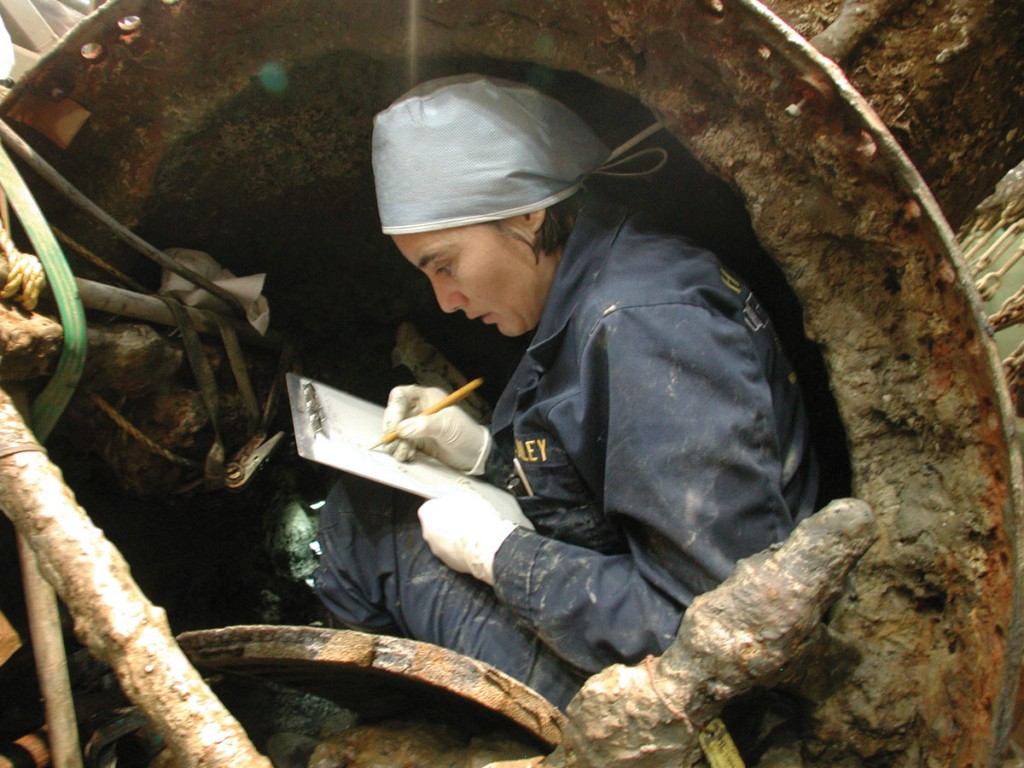
Senior archaeologist Maria Jacobsen works in the Hunley’s crew compartment during the final excavation of human remains in 2004. Image courtesy Friends of the Hunley.
The most unusual finds included remnants of human flesh. Pieces of fatty tissue were recovered from several places, including the insides of skulls. Jacobsen and Mardikian found, in the insert of a shoe, remnants of the human heel that once pressed into it, along with a clear impression of skin. Mardikian’s biggest surprise was finding fingerprints embedded in a sample of concretion found on the sub’s floor. Basically, a hard crust that forms when carbonates in seawater combine with iron, concretion can essentially fuse organic material to an iron substrate. In this remarkable case, the process recorded the only fingerprints of a Hunley crewmember known to exist.
The question that had been on the minds of archaeologists from the start—whether the remains held any recoverable DNA—was soon answered. The team successfully recovered DNA from all eight skeletons. (The project’s forensic panel represents multiple fields of science and forensic specialties. Doug Owsley, head of physical anthropology at the Smithsonian Institution, leads the study of bones; Jamie Downs, regional medical examiner of the Georgia Bureau of Investigation, is in charge of the pathological investigations; and Linda Abrams, U.S. Army forensic genealogist, heads the genealogical research.) Work to date has identified and named five members of the eight-man crew and established the origins of some of them. Four were found to be native Europeans.
Aside from what chemistry revealed about the Hunley’s last crew, their skeletal remains speak volumes about the men, Jacobsen says. Scholars have suggested that all of the men who served aboard the vessel likely were picked mainly because of their stature. It was thought that only short men could manage to squeeze into the sardine can that was the Hunley. The story told by the bones found by the Lasch team proved otherwise.
“These men were taller than the average men of the Civil War, and in fact two of them were nearly six feet tall,” Jacobsen says. “They were clearly not picked for their stature. And in looking at their profiles, we realize that these were handpicked men who were seasoned. This was absolutely a special ops team.”
The final phase
For all of the attention, drama, and exciting science that the discovery of the Hunley’s last crew brought to the Lasch Center’s lab, the inescapable fact is that it put the conservation of the vessel on a vastly different timetable. Mardikian believes that had human remains never been found, in all likelihood the Hunley would have been put on public display in its own museum years ago, and displaying the vessel remains the preeminent goal.
“The presence of human remains added enormous constraints to the overall project’s timeline,” he says. “Because of this, using chemicals was not an option. I’m pretty confident that had the vessel been found empty of remains we could have finished conservation in less than seven years. And if it had been found in freshwater instead of saltwater, three.”
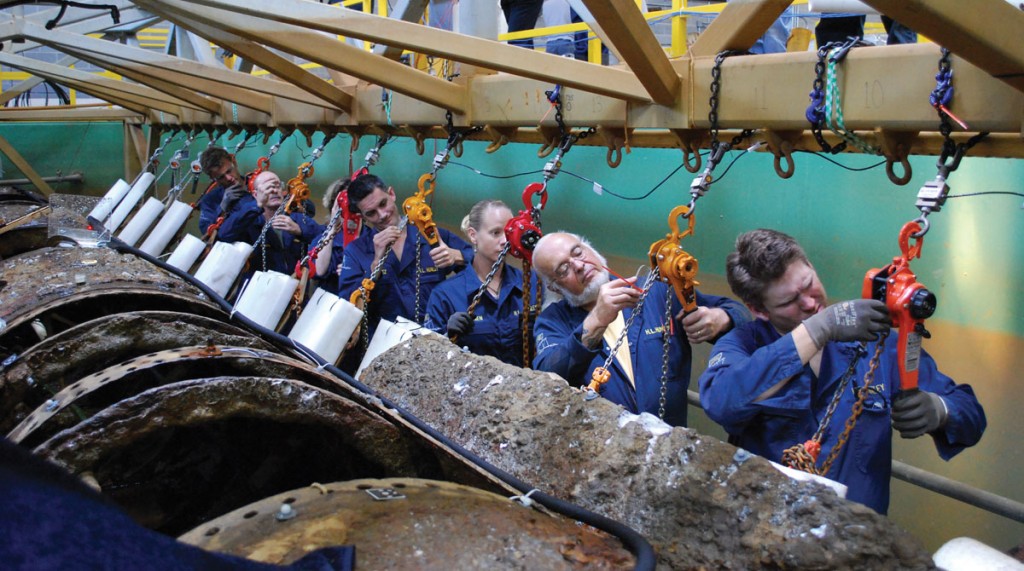
Righting the ship: After its recovery from the sea in 2000, the submarine was kept at exactly the angle (roughly 45 degrees) at which it was found to protect its contents and structural integrity. In June 2011, a crew of scientists and engineers rotated the Hunley to its original position using carefully coordinated adjustments. Tension sensors mounted above each station fed information to a computer monitored by Vincent Blouin, assistant professor in the School of Architecture and the School of Materials Science and Engineering, who made sure the rotation was smooth and even, to avoid stressing or breaking the fragile sub. Before the rotation, Blouin and graduate student Aditya Choragudi used multiple computer-based models to calculate potential stresses on the hull. The photo above shows an early stage of the rotation. Later, fifteen people tended the port side. Image courtesy of Friends of the Hunley.
Equally vexing is the way the Hunley is constructed and its condition after lying in saltwater for well over a century. The vessel is a veritable medley of metals, each with its own chemical characteristics, which often overlap or otherwise come in contact with each other, making standard treatment protocols extremely tricky. Moreover, the vessel overall is highly corroded, but not uniformly so. Extremely fragile sections often are found right up against solid ones. Even after all the human remains and other organic materials were removed, switching to a one-step, fast-track approach to stabilizing the vessel would have posed risks to the ship, Mardikian says. In 2006, Mardikian submitted to the U.S. Navy a conservation plan for the Hunley, and the plan was approved by several federal agencies, the Smithsonian Institution, and international leaders in the fields of conservation, underwater archaeology, and historic preservation.
Now that the ship’s hull has been rotated into its correct position, the team plans to bathe the Hunley in a dilute solution of sodium hydroxide, a caustic chemical used to leach out the salts from corroded metal. No matter what process is used, pulling chloride ions out of a complex iron structure that spent more than a century in seawater can take years.
“We may never be able to extract all the salts in a reasonable amount of time without taking the submarine completely apart,” Mardikian says. The Navy’s priority, he says, is to maintain the integrity of the submarine during conservation and to prepare it for display in a condition that minimizes corrosion and the need for future conservation.
After the submarine has bathed in caustic chemicals for about three months, the team plans to drain the Hunley’s tank, and conservators armed with both manual and pneumatic chisels will begin chipping away at the brown encrustation that conceals the surface of the sub. Only when they gaze upon the original skin of the Hunley will Lasch researchers be able to draw final conclusions about what happened on its famous mission. Learn more about what really happened to the Hunley.
“We must look at the surface,” Mardikian says. “That’s where we believe some of the best clues lie.”
Into new waters
The Lasch Center itself is a converted warehouse that once was part of the famed Charleston Naval Yard, a base for tens of thousands of military personnel who served the nation through four wars. As a cost-cutting measure, in 1996 Congress shut the base down. In 2005, Clemson announced big plans for reviving the area. A donation of eighty acres of land by the City of North Charleston, along with $10.3 million in state matching funds, gave the university a green light to proceed with plans to turn the property into a research park and home for the newly formed Restoration Institute. The country’s economic malaise slowed progress, but the project finally is taking shape, with a mission in renewable energy research. Last summer, a $100 million wind-turbine testing facility, reported to be the largest of its kind in the world, cranked up there, bringing eighty jobs to the area. With its foot in the door of materials science, the Lasch Center has positioned itself to become a full partner in the park’s energy research.
Since assuming control of the Hunley project, administrators recognized the remarkable potential that the Hunley project held for advancing the fields of archaeology and conservation. Given its worldwide fame, the project was seen as a natural candidate for research that could have a lasting impact on technologies ranging from corrosion control to materials fabrication and preservation.
Today, the team’s innovative work has reached the attention of scholars the world over. Since 2007, the center has published dozens of papers and made presentations at professional groups around the world. In 2010, the attention made the center host for Metal 2010, the largest gathering of metal conservators in the world, sponsored by the Paris-based International Council of Museums. The team is excited by some of the ideas already taking shape as direct spin-offs of the center’s work. But they are mindful that the most pressing task at hand is the Hunley itself, and getting it ready for its final home. “We have to finish what we started,” Drews says.
Exactly how the submarine will be presented to the public involves details yet to be worked out, Drews says. But he already knows that it will involve putting the vessel in a special place where people can see but never touch it.
“I envision it being in something like a Plexiglas terrarium and kept very dry,” he says. “The air would be replaced with some inert gas, preferably argon, which is heavy and tends to stay in place.” By keeping tight controls on temperature, humidity, and exposure to oxygen, the Hunley’s corrosion could be held in check to a level that would be “almost imperceptible” after a century, Drews says.
Peaceful legacy?
Each year, upwards of 10,000 visitors find their way to the sylvan grounds of Charleston’s oldest public cemetery, Magnolia. Founded in 1849, the cemetery earns its listing on the National Register of Historic Places in large part by being the final resting place of hundreds of Confederate dead, including five generals and all three crews of the H.L. Hunley.
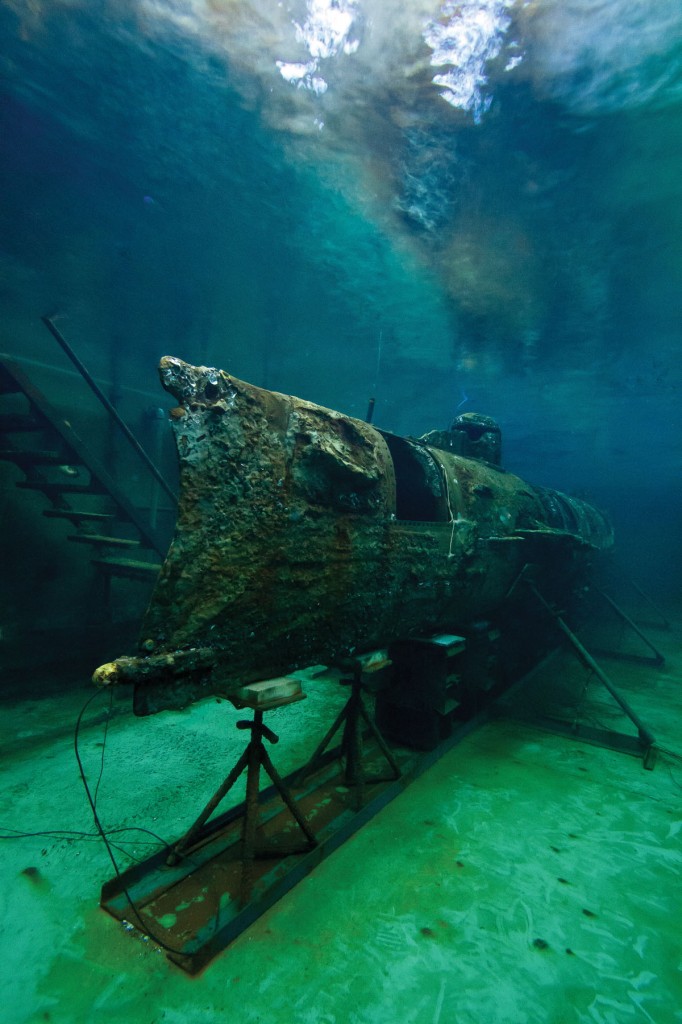
Submerged in its tank, the Hunley slowly releases an accumulation of salt that would destroy it, if the ship were left exposed to air. Once it has been treated with a mild solution of caustic chemicals, the sub may be stable enough for the conservation team to begin removing the concretions that cover its surface. Will that reveal the secret of what sank the Hunley? No one knows for sure. But once the job is done, visitors will view the sub much as it appeared 150 years ago. Image courtesy of Friends of the Hunley.
Cards, letters, hastily written notes, and other memorials commonly adorn the graves of Hunley, Dixon, and their comrades. We found a handsome printed tribute left by an international submariners group who obviously went to considerable lengths to pay their respects. Such far-flung attention underscores what others have said and written about the legacy of the H.L. Hunley.
The story transcends borders, politics, ideology, race, age, and gender.
Yet some critics can’t get past the legacy’s unshakable ties to a renegade government hell-bent on protecting a venal economic system built on slavery. To their mind, the only lesson worth remembering is that the Hunley fought on the wrong side of history. Revering the old vessel and keeping its memory alive is impolitic at best.
While conceding the point on slavery, others argue that history is rarely this simplistic. Historians generally agree that the Hunley represents one of the most important milestones in the evolution of modern warfare that, for better or worse, fundamentally altered the course of history. Supporters argue that this fact stands independent of, and untarnished by, the sins of man, no matter how egregious, and therefore easily merits Clemson’s investment at the Lasch Center.
Civil war historian Paul Anderson, associate professor of history at Clemson, says that people who would bury the Hunley—again—are essentially saying that they don’t want to learn anything about the South’s painful past. The project, he argues, represents a core mission of Clemson or any other university, namely, the pursuit of knowledge.
“Our job is to discover the past, not ignore it,” he says.
Drews sees the university’s role in a purely academic light as well. To him, the Hunley project is education, research, and service—the three-legged stool upon which any university worthy of the name rests. Clemson happens to be in the enviable position of helping to make a rare cultural treasure available to science and the world, he says.
“To a scientist, engineer, or naval historian the Hunley represents a nineteenth-century technological marvel that, unknown to those who built or manned it that night, changed the world in February 1864.”
In March 2001, researchers probing the muddy interior of the Hunley found the first bones.
Much of what people believed about the Hunley turned out to be flat wrong. And here’s what the team has discovered so far.
Nearly 150 years later, it’s still the mystery that a dozen years of studying the Hunley’s bones has yet to solve.
Museums throughout the world groan beneath the weight of iron artifacts recovered from the sea.
In addition to the subcritical treatment of archeological iron, Clemson research on the Hunley archeology project has produced two other promising spin-off technologies. Read more.
Friends of the Hunley
1250 11th Street
North Charleston, SC 29405
843-743-4865, ext. 10
www.hunley.org
The Hunley Project is conducted through a partnership of the South Carolina Hunley Commission, the Clemson University Restoration Institute (CURI), the Naval Historical Center, and Friends of the Hunley. CURI’s executive director is John W. Kelly, Clemson’s vice president for economic development.



